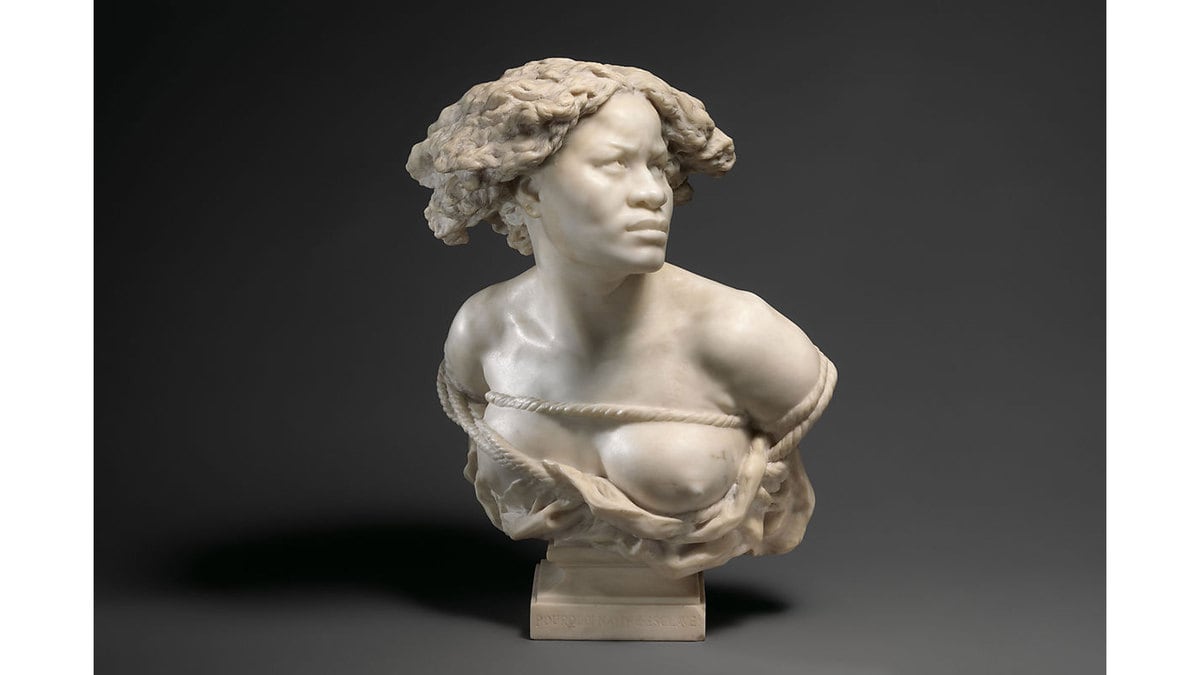Jean-Baptiste Carpeaux’s classic marble sculpture Why Born Enslaved! (1868) shows the bust of an unknown Black woman. Tattered clothing exposes a bare breast, and Afro-textured hair frames the woman’s face. Her nose flares as she looks over her left shoulder in fear, agony, with possibly a mixture of disgust and desired vengeance.
The sculpture is at the center of a new exhibit, Fictions of Emancipation: Carpeaux Recast, at the Metropolitan Museum of Art in New York City. Multiple variations are showcased along with modern takes and reworkings of the piece. Surrounding the sculpture are variations made of terracotta, plaster and paint, and unbaked clay—all crafted by Carpeaux. A plaster shell reworking, Negress (2007) by Kara Walker, is perched in a corner.
A contemporary rendition of the sculpture featuring a basketball player in a similar pose, After La Negresse (2006) by Kehinde Wiley, sits near the original. Fixed at the center of the room, the popularity of Why Born Enslaved! is seen with its various spawns circling it. The perimeter of the room is adorned with other pieces of artwork unrelated to Why Born Enslaved!—but similar in context.
What the show highlights are a series of profound dislocations of perception: We see right in front of us how 19th century artwork featuring Black subjects by white artists represented and misrepresented those subjects, and then today we see those same subjects re-interpreted, realizing how they were once mistakenly seen, and pondering who they really were.
The exhibit redirects the conversation of tone and purpose of ethnographic 19th century European art. In an effort to correct racial inaccuracies featured in the Met’s 150-year existence, current curators and historians attempt to highlight misrepresentations and fallacies of the supposed Black experience that was created by white artists.
Entering the exhibit, I was immediately pulled to a quote printed on a wall by Dr. Fabienne Kanor, a writer, filmmaker, and Pennsylvania State University professor, talking about her childhood in France. She detailed her experience watching La Noiraude, a TV show about a black cow that continuously had bad luck. No matter what, the cow always seemed to run into some sort of obstacle, and Kanor loved it.
“Like millions of French people, I listened to the black cow’s laments, and I laughed. I laughed at her,” Kanor said. “I laughed to tears until some white schoolmates decided to baptize me ‘La Noiraude.’ And then the TV screen became a mirror. And I became La Noiraude. And then I became a problem. Representation is not something to be taken lightly. When it is false, it is heavy. …It stops us from flying toward our authentic selves.”

Allegory of Africa, Frédéric-Auguste Bartholdi (French, Colmar 1834–1904 Paris), modeled ca. 1863–64
The Metropolitan Museum of ArtMoving clockwise around the edge of the room, the artwork starts with Jean-Léon Gérôme’s Bashi-Bazouk (1868–69), an oil painting of a Black male model costumed in silk fabric to capture the artist’s idea of a Turkish soldier in the Ottoman Empire. Next comes Charles-Henri-Joseph Cordier’s sculpture Woman From the French Colonies (1861). A Black female model is draped in a seemingly luxurious robe to represent a type rather than an accurate portrait. The bust exoticizes the concept of the Black woman as an object and novelty. Even the title demeans her identity.
“These works are incredibly beautiful, in terms of their materiality and their artistic bravura,” Fictions of Emancipation co-curator Elyse Nelson told The Daily Beast. “But underlining them is something incredibly harmful as well. I think it’s really important for us to have more honest, clarifying conversations around what underpins those works.”
“Representations are charged,” co-curator Wendy Walters explained. “They are used in context. In some ways, it’s about getting a stronger sense of understanding about how representation is used before one evaluates it, as opposed to just seeing it be present because of the novelty of it or the unusualness of it and assuming that it’s good.”
The exhibit dives into racial tropes enveloped in classic pieces of art that were considered groundbreaking and socially enlightening during the time of their creation. Signs throughout the exhibit explain that artists of the period created “fantasy portraits of colonized subjects.”
White artists wanted to tell the stories of Black people how they viewed Black people. Black artists were far and few in-between during the years after slavery was abolished in European colonies, so storylines relied on white artists trying to explain a livelihood from the outside looking in. In turn, Black models—who financially struggled—were hired to convey the message white artists wanted to tell. Their Blackness was exploited as forms of propaganda.
“At what point do you move on from this narrative? …Why rehash this predatory, racist history?” Nelson said. “Why continue to tell the story that Black communities are so familiar with? And the truth is that I feel that the Met cannot move beyond it until it’s done the work of addressing its own institutional colonialism. The ways in which we have presented these works of art and displayed them to the public for a century have been acts of white supremacy. This exhibition seeks to address that critically.”
Nelson and Walters acknowledged that they were unsure of the reason why there was an influx of emancipation art after slavery in the Western Hemisphere was abolished. It was a time when places that once held enslaved Africans were no longer the focus and a new wave of colonization in North Africa and Southeast Asia became the trend. The white elite wanted to show how socially progressive they were and would commission artists to create pieces for their liking.
Maybe it was a sense of nostalgia or white guilt. Regardless, those classic sculptures and paintings demonstrated something to the public that wasn’t real. Being Black was synonymous with the term “slave” and inferiority.
There were remnants in the exhibit that reminded me of my childhood. Just like the passage from Kanor, I had a realization of cartoons I’d watch that made me feel uncomfortable, as if I was witnessing something forbidden and dark.
Coming across the Allegories of the Four Parts of the World (1730-32) by Johann Justin Preissler, I saw four types of women who were deemed to be representations of the global quadrants. The European woman was adorned with a crown and fully clothed. The Native and African women were undressed and surrounded by wild animals to indicate a level of savagery.
Tunes from syndicated 1950 and ’60s-era Merrie Melodies rang in my head when a cartoon would feature a story in the jungle and what was considered standard exotic music would heavily play in the forefront. Wild tribal members would yell and jab their spears at whoever was seen as an intruder. The intruder would be afraid of the tribe who—of course—were cannibals and practiced some heathen primal religion.

(L) Print of a Free Man, Louis Darcis (French, died 1801), 1794, (R) Print of a Free Woman, Louis Darcis (French, died 1801), 1794
The Metropolitan Museum of ArtThen, there was a pair of illustrations by Louis Darcis: Print of a Free Man (Moi Libre Aussi) (1794) and Print of a Free Woman (Moi Libre Aussi) (1794). A Black man and Black woman with over-emphasized bulbous lips and large eyes making a plea for their humanity. It simply reminded me of the banned cartoons I found online after I became older—and other cartoons I watched as a kid that were never deemed offensive enough to be taken out of circulation.
“Stereotypes. I think that notion of humans as typological categories still exists,” Nelson said. “It’s so hurtful that we view people as types rather than as individual humans. …For me, that’s the danger.”
At the heart of the exhibit is Why Born Enslaved! I stared at the sculpture of the woman, trying to understand what the model felt at the time she posed for Carpeaux. Did she realize the extent of which her image would carry, that her story would be misconstrued as a tale of triumph rather than a white artist exploiting her Blackness for his own artistic motives?
The sculpture was originally titled La Negresse, a degrading term simply meaning “Black woman.” The model/subject is so far removed from being human that her Blackness—and sexual objectivity—is singular enough to be its own artistic subject.
Over time, the sculpture has gained recognition and grown in fame. It has been featured in an Ivy Park ad with Beyoncé; Janet Jackson has a copy of the mold in her home. At one point, Why Born Enslaved! was heralded as racial progress for including subjects of Black people, especially Black women. But the tone and context of the artwork has to be considered; there’s more to it than filling a void.
Instead, it creates a misrepresentation that Black people could feel only one emotion, that they had no concept of joy because of bondage, that they were not complex human beings with variety. However, Black people are dynamic like any other group and deserve accurate portraits to convey their real lives.
Black audiences see the same bait and switch in pop culture today. ABC is infamous for creating shows about Black people but for white viewers. It’s as if it’s a disguise for diversity—when in reality it’s a level of Blackness that will keep white people comfortable. Black stories on film tend to focus on slavery or the Civil Rights movement. They have come to be known as “Black trauma porn” where Black stories can only be accepted when the performers are playing enslaved people or fighting through Jim Crow.

Abolitionist Jug, ca. 1820
The Metropolitan Museum of ArtThe Help received a wave of criticism from Black readers and viewers due to its white-savior complex. The Black women who worked as maids throughout the Mississippi town had no concept of happiness without the white protagonist. Though stories need to be told for historical context, other Black narratives need to be shared for more accurate and modern portrayals.
“I think that there’s a challenge with works that are supposed to fill in for a lack of representation,” Walters said. “It makes it seem like that work has already been done, [like] we don’t need any more representation because it already exists. That’s an issue in terms of what images or what works get reported and what gets made in the present tense.”
Though the Met works to initiate conversations about representation and changing how classic works are viewed, Black people still are not totally in control of their narrative. During the press opening, a vast majority of the audience who attended the exhibit were white. Though it’s making an effort to fix the kink in the chain, the industry is still like a bastardized form of telephone where the story gets misconstrued farther and farther down the line.
“We wanted to create different levels of opportunity for people to respond to the works put forward,” Walters explained. Along with the exhibit, the curators organized a display where people could write their thoughts on the meanings of representation, abolition, legacy, and central Black figures in art.
One person wrote that the legacy of Black art is the lack of humanization. Another said that abolition is about breaking chains, while another wrote that it is “rewriting the historical canon to prioritize and uplift Black voices, dismantling ever-present systems of systemic racism.” “Voices of power” was noted as the key force in who narrated history.
“We put this forward as a way to say this is a complicated set of works,” Walters continued. “We want you to look at them and we want to know what you think about them. …Some people can’t stand these works. Some people adore them. Some people are ambivalent about them. There’s not a single response from Black audiences that we’re anticipating. We want to make a place for that multiplicity response because that’s what people do. People respond in multiplicities.”
“I think that this work had to be done because these works are already in view at the Met, and they’ve never been critically addressed,” Nelson said. “We talked about it as maybe a pivot point. Let’s address it and then let our audience and the community tell us how to move forward. Let’s learn from it.”







